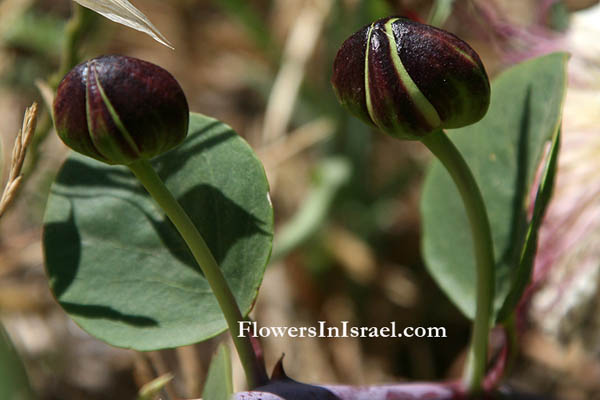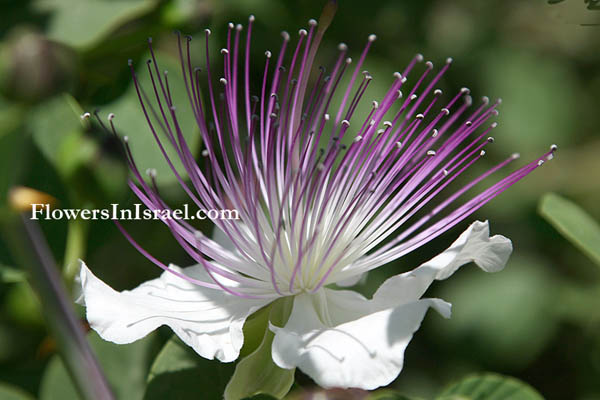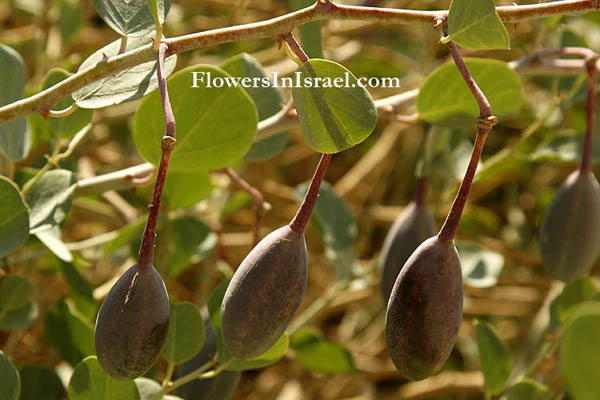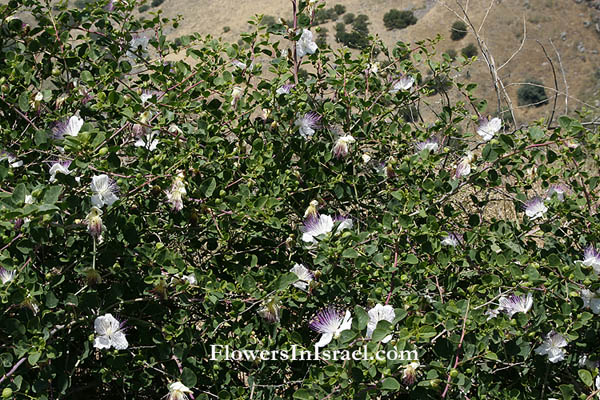
Flower buds
Derivation of the botanical name:
Capparis (latin), borrowed from Greek kapparis [κάππαρις], whose origin is unknown but probably West or Central Asia (Alkabara, kabar). Another theory links kapparis to the name of the island Cyprus (Kypros [Κύπρος]), where capers grow abundantly. Arabic kafara, to be hairy, villous.
spinosa, "thorny", refers to the pair of hooked spines at the base of each leaf stalk.
The Hebrew name: צלף, tzalaf, zalaph, which in the Bible is a proper name (Nehemia 3:30). The caper's fruit, the evyonah, is mentioned in Ecclesiastes 12:5 as a symbol of shortness of man's life, because very soon after it blossoms, the fruit scatters its seeds and the plant withers; "The almond-tree shall blossom… and the caperberry shall fail; Because man goeth to his long home…."
- The standard author abbreviation L. is used to indicate Carl Linnaeus (1707 – 1778), a Swedish botanist, physician, and zoologist, the father of modern taxonomy.
The plant contains the anti-oxidant bioflavinoid rutin which also contributes to the flavor. The white spots often seen covering the surface of pickled capers are said to be rutin which crystallized during the pickling procedure.
The caper was used in ancient Greece as a carminative (medication for treating gas in the digestive system). It is represented in archaeological levels in the form of carbonized seeds and rarely as flower buds and fruits from archaic and classical contexts.
See the list of Medicinal herbs in Israel, the parts used and their medical uses to treat various diseases.
-
Athenaeus (200CE) in Deipnosophistae (Deipnosophists or Banquet for the Learned) pays a lot of attention to the caper, as do Pliny (NH XIX, XLVIII.163) and Theophrastus.
-
Pliny the Elder (23-79 CE) writes in Natural History XIII 127:"...a shrub with a rather hard wood; also its seed is well known as an article of food, and is usually gathered together with the stalk."
Pedanius Dioscorides (40-ca. 90CE) also provides instructions on the use of sprouts, roots, leaves and seeds in the treatment of strangury and inflammation. He describes it as spreading in a circular manner on the ground, in poor soils and rugged situations.
-
Powdered root bark is quoted by the Venetian Prospero Alpini (1553-1617) as a treatment for skin ailments, and as a vermifuge (substance which kills worms) and emmenagogue (substance that stimulates menstruation).
- The Biblical Aviyonah (אַבַיּוֹנָה, abiyonah', from אָבָה, to desire Sept. κάππαρις) is mentioned only once in the Bible (Eccles. 12:5): "when the almond tree blossoms and the grasshopper drags itself along and desire no longer is stirred. Then people go to their eternal home and mourners go about the streets." The word here translated desire has been considered to signify the Caper-berry. Although the NIV translates the Hebrew avionah as "desire," this chapter is a well-known allegory of old age with reference to sight, hearing, white hair, and, eventually, death. Included in the list of features of old age is when "...the caper berry is ineffective" - likely a reference to the use of the caper fruit, technically a berry, as an aphrodisiac. The Aviyonah, the fruit of the Capparis spinosa, is mentioned as a symbol of shortness of man's life, because very soon after it blossoms, the fruit scatters its seeds and the plant withers; "The almond-tree shall blossom… and the caperberry shall fail; Because man goeth to his long home…."
- The Mishnah calls it tzalaf / zalaph, צלף , (Beza 25a, cf. Shabbath 30b), which is in the Bible a personal name (Nehemiah 3:30). The plant produces new fruit daily and Rabban Gamaliel, a leading authority in the Sanhedrin in the early 1st century CE, used this phenomenon as proof that in messianic times "trees will yield fruit every day" (Shab. 30b).
- Henry Baker Tristram (1822-1906) writes: In the Holy Land, we saw the Caper hanging from the walls of Jerusalem, and especially round the Harem, the old temple area.
The flowers of wild caper bushes are a common sight in all countries surrounding the Mediterranean Sea, extending even to the Sahara in North Africa and the dry regions of Central Asia, where the plant is thought to have originated. The delicate, cream-white petals and lively purple stamina persist only a few hours. Besides, the flowers are rarely seen in caper gardens as the capers are picked daily, since the youngest flower buds (about the size of peas) have the highest quality. Capers are valued in proportion to the smallness of their size.
Capers are cultivated in France, Spain, Italy, Algeria, Iran, Cyprus and Greece. The flower buds are pickled in oil, brine or vinegar and used as a flavouring in sauces, salads. The fragrance is spicy and a little bit sour (because of the pickling); the taste is slightly astringent and pungent.
The young fruits (French cornichon de capres, in English also known as caper berries) and tender branch tips can also be pickled and used as a condiment.
Caper berries have a stronger, more dominant but otherwise similar flavour.
Bible resources:
- Eccles. 12:5
Also when they shall be afraid of that which is high, and fears shall be in the way, and the almond tree shall flourish, and the grasshopper shall be a burden, and desire shall fail: because man goeth to his long home, and the mourners go about the streets.
Desire - literally, the caper-berry; which, eaten as a provocative to appetite, shall fail to take effect on a man whose powers are exhausted. The Jewish Encyclopedia points out, the female form abiyyonah should strictly mean "the desiring thing", rather than "desire" itself.
קהלת יב ה
מגבה יראו וחתחתים בדרך וינאץ השקד ויסתבל החגב ותפר האביונה כי הלך האדם אל בית עולמו וסבבו בשוק הספדים
אֲבִיּוֹנָה ,והיא מילה יחידאית - מופיעה בתנ"ך פעם אחת בלבד.
במקור היה זה כינוי לצמח הצלף הקוצני, ובהמשך (אצל חז"ל) המילה קיבלה משמעות של תשוקה מינית.

Flower

Fruits
|



